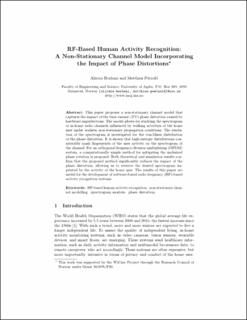RF-Based Human Activity Recognition : A Non-stationary Channel Model Incorporating the Impact of Phase Distortions
Chapter, Peer reviewed
Accepted version
Permanent lenke
https://hdl.handle.net/11250/2648460Utgivelsesdato
2019Metadata
Vis full innførselSamlinger
Originalversjon
Borhani, A. & Pätzold, M. U. (2019). RF-Based Human Activity Recognition: A Non-stationary Channel Model Incorporating the Impact of Phase Distortions. In I. Rojas, G. Joya & A. Catala (Eds.), Advances in Computational Intelligence (11506, p. 335-346). Cham: Springer. doi: 10.1007/978-3-030-20521-8_28Sammendrag
This paper proposes a non-stationary channel model that captures the impact of the time-variant (TV) phase distortion caused by hardware imperfections. The model allows for studying the spectrogram of in-home radio channels influenced by walking activities of the home user under realistic non-stationary propagation conditions. The resolution of the spectrogram is investigated for the von-Mises distribution of the phase distortion. It is shown that high-entropy distributions considerably mask fingerprints of the user activity on the spectrogram of the channel. For an orthogonal frequency-division multiplexing (OFDM) system, a computationally simple method for mitigating the undesired phase rotation is proposed. Both theoretical and simulation results confirm that the proposed method significantly reduces the impact of the phase distortion, allowing us to retrieve the desired spectrogram imprinted by the activity of the home user. The results of this paper are useful for the development of software-based radio frequency (RF)-based activity recognition systems.
